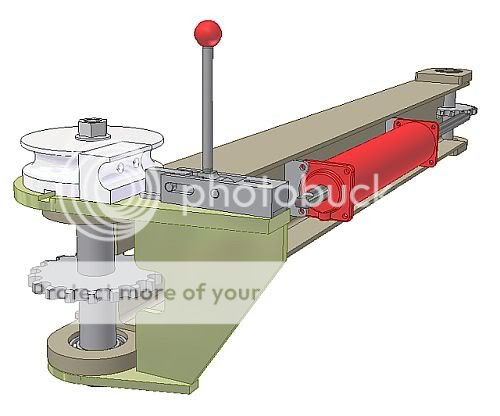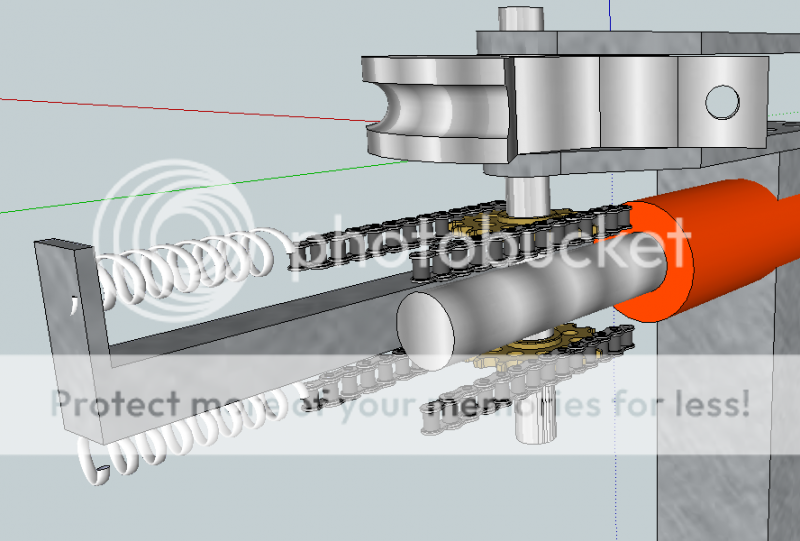We noticed you are blocking ads. DO THE TON only works with community supporters. Most are active members of the site with small businesses. Please consider disabling your ad blocking tool and checking out the businesses that help keep our site up and free.
You are using an out of date browser. It may not display this or other websites correctly.
You should upgrade or use an alternative browser.
You should upgrade or use an alternative browser.
New Tube Bender Design Input
- Thread starter SONICJK
- Start date
Check out this design:

I found on this page:
http://bbs.homeshopmachinist.net/threads/39010-Torque-or-force-to-bend-tubing
Which is the poor man's version of the Pine's bender:


I found on this page:
http://bbs.homeshopmachinist.net/threads/39010-Torque-or-force-to-bend-tubing
Which is the poor man's version of the Pine's bender:

the chains are wrapped? the pitchur dont show that
anyway if something hangs up that cylinder will overpower and just wreck shit though
gonna be a fuklode of force on you're shaft at the die are you thinking just a keyway ?
....why not just push on a giant rachet lashup? with a large diameter rod on the cylinder return speed can be maximised
the other option you have not 'splored is a worm gear drive
anyway if something hangs up that cylinder will overpower and just wreck shit though
gonna be a fuklode of force on you're shaft at the die are you thinking just a keyway ?
....why not just push on a giant rachet lashup? with a large diameter rod on the cylinder return speed can be maximised
the other option you have not 'splored is a worm gear drive
Sonic your first design isn't that far off! When I was starting out in the offshore workplace I worked in the instrumentation field and we bent tubing all day long for process and stuff. I've bent from 1/8" stainless to 1" 2507 stainless steel and 2507 is stiffer then any seat hoop tubing that your going to bend. Back in 98 we had a hydraulic bender for the larger tubing that was similar to your sketch but the shoe was at the end of the ram on a pivot. The shoe was not fixed to the framework of the bender, instead fixed to the ram. It had a roller with a pin that went through both top and bottom plates and when you ran the hydraulic power pack it would drive the shoe and block up against the roller and it would bend the tubing. The shoe also had a hook at the front of it to secure the tube in place. We did a job that had 28,000 ft of 1" tubing to bend and had no problems with that design. Later on we switched to electric benders made by Rothenberger. These are very rugged and easy to use. They are about the size of a pipe threader. They are set up where the shoe is fixed and is gear driven. There is a hook on the front of it to secure the tubing and a roller pin to bind against the tubing. I don't have the sketch up skills to draw it out, so here is a link.
This is the Rothenberger. Ive bent some stout tubing with this with no problems.
http://www.rothenberger-usa.com/en/products/rothenberger/by-applications/bending-93/bender-electric-105/
This is the Rothenberger. Ive bent some stout tubing with this with no problems.
http://www.rothenberger-usa.com/en/products/rothenberger/by-applications/bending-93/bender-electric-105/
The Rothenberger is driven by a rotary actuator. I would have suggested that, but he's trying to do it for less than $200 - $300. You can get rotary actuators for as little as $100, but I'm not sure they would have the necessary torque or rotation. Most that rotate 180 degrees and have the torque are $300 to $3000 used on eBay.clem said:Sonic your first design isn't that far off! When I was starting out in the offshore workplace I worked in the instrumentation field and we bent tubing all day long for process and stuff. I've bent from 1/8" stainless to 1" 2507 stainless steel and 2507 is stiffer then any seat hoop tubing that your going to bend. Back in 98 we had a hydraulic bender for the larger tubing that was similar to your sketch but the shoe was at the end of the ram on a pivot. The shoe was not fixed to the framework of the bender, instead fixed to the ram. It had a roller with a pin that went through both top and bottom plates and when you ran the hydraulic power pack it would drive the shoe and block up against the roller and it would bend the tubing. The shoe also had a hook at the front of it to secure the tube in place. We did a job that had 28,000 ft of 1" tubing to bend and had no problems with that design. Later on we switched to electric benders made by Rothenberger. These are very rugged and easy to use. They are about the size of a pipe threader. They are set up where the shoe is fixed and is gear driven. There is a hook on the front of it to secure the tubing and a roller pin to bind against the tubing. I don't have the sketch up skills to draw it out, so here is a link.
This is the Rothenberger. Ive bent some stout tubing with this with no problems.
http://www.rothenberger-usa.com/en/products/rothenberger/by-applications/bending-93/bender-electric-105/
drap a welding jacket or a towel over it and that chain won't go anywhere if it breaks I use to run a frame machine in a auto body shop and that all we ever did works great, if a clamp or a chain let loose. If some of you engineer type spent as much time using tools as you did talking about them and making cad drawings this thing would be built by nowSONIC. said:Party at my place, and junior volunteered to be the first to use the new bender! No chain guard of course because those are for pussies 8)
LOL. I am already too drunk to use tools.bradj said:If soom of you guys spent as much time using tools as you did talking about them and making cad drawings this thing would be built by now
Sonic, your over and under design looks perfect. Exactly what I thought at first. The larger sprockets are not so much about strength as mechanical advantage. The smaller the sprocket(s), the more force the ram must deliver for the same torque at the die. So larger is better within the constraints of ram travel and of course practical physical size. Make sure the fixed end of the ram is "behind" the chain where it wraps the sprocket (you show it this way) or it will require a guide at the ram end, and also make sure the centerline of the ram is exactly centered on the chain where it starts to leave the sprocket (90 degrees to the center.) because it will go there on it's own very forcefully. Brad's idea of the welding blanket is good, but of course, only for pussies as technically it works out to a chain guard.
This design is used all the time in forklifts. It will work great, the only thing to work-out is sprocket diameter to get you the range of motion that you want.SONIC. said:
There is a much easier/cheaper solution. I modified my JD2 Model 32 to return when it is done bending. It won't do 180* in one sweep, but literally, when you let the pressure off it returns to zero. Pull the pin, reset, and go. It cost about $10 and I used parts from Lowe's. Hang on I'll grab some pics.
Here you go....a little bit of angle iron, a cut up cb750 kick stand, two Lowes springs (initially tried one but wasn't strong enough), and a $10 craigslist engine stand and you have a vertical or horizontal bending, self returning, fully mobile tube bender.






Hoosier Daddy
Earache my eye...
xb33bsa said:you don't want those type of side pull/bending loads on the ram/cylinder the rod bushing will be to highly loaded as will the piston they are not designed for that type of load neither
Beat me to it but glad it was brought up...
deviant said:Check out this design:

Now you're talking, That is more like what I was going to try and describe with it's double ended rod to eliminate the spings. With the chain But because I have nearly no CAD skill you would have had to os your "Minds Eye" imagination or look at some MS Paint drawing that would have taken me all day. :
I am the Maintenance Manager at a factory full of pipe benders capable of bending up to 3 1/2" stainless pipe. The older ones are Hydraulic similar in design. The Newer machines are all electric with servo motors and ballscrews like the one in this video.... but our "Safety Nazi" would have a heart attack if you could reach past all the gaurding, light curtains, and scanners while the machine was still in motion!
http://www.youtube.com/watch?v=9zafbhVGNjk






